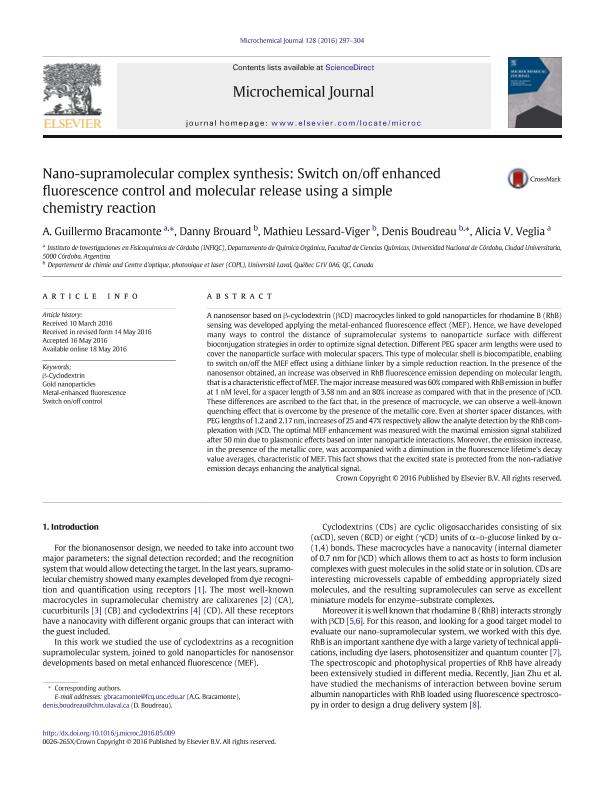Mostrar el registro sencillo del ítem
dc.contributor.author
Bracamonte, Angel Guillermo

dc.contributor.author
Brouard, Danny
dc.contributor.author
Lessard Viger, Mathieu
dc.contributor.author
Boudreau, Denis
dc.contributor.author
Veglia, Alicia Viviana

dc.date.available
2018-08-03T20:30:48Z
dc.date.issued
2016-09-18
dc.identifier.citation
Bracamonte, Angel Guillermo; Brouard, Danny; Lessard Viger, Mathieu; Boudreau, Denis; Veglia, Alicia Viviana; Nano-supramolecular complex synthesis: Switch on/off enhanced fluorescence control and molecular release using a simple chemistry reaction; Elsevier Science; Microchemical Journal; 128; 18-9-2016; 297-304
dc.identifier.issn
0026-265X
dc.identifier.uri
http://hdl.handle.net/11336/54164
dc.description.abstract
A nanosensor based on β-cyclodextrin (ßCD) macrocycles linked to gold nanoparticles for rhodamine B (RhB) sensing was developed applying the metal-enhanced fluorescence effect (MEF). Hence, we have developed many ways to control the distance of supramolecular systems to nanoparticle surface with different bioconjugation strategies in order to optimize signal detection. Different PEG spacer arm lengths were used to cover the nanoparticle surface with molecular spacers. This type of molecular shell is biocompatible, enabling to switch on/off the MEF effect using a dithiane linker by a simple reduction reaction. In the presence of the nanosensor obtained, an increase was observed in RhB fluorescence emission depending on molecular length, that is a characteristic effect ofMEF. Themajor increase measuredwas 60% compared with RhB emission in buffer at 1 nM level, for a spacer length of 3.58 nm and an 80% increase as compared with that in the presence of ßCD. These differences are ascribed to the fact that, in the presence of macrocycle, we can observe a well-known quenching effect that is overcome by the presence of the metallic core. Even at shorter spacer distances, with PEG lengths of 1.2 and 2.17nm, increases of 25 and 47% respectively allowthe analyte detection by the RhB complexation with ßCD. The optimal MEF enhancement was measured with the maximal emission signal stabilized after 50 min due to plasmonic effects based on inter nanoparticle interactions. Moreover, the emission increase, in the presence of the metallic core, was accompanied with a diminution in the fluorescence lifetime's decay value averages, characteristic of MEF. This fact shows that the excited state is protected from the non-radiative emission decays enhancing the analytical signal.
dc.format
application/pdf
dc.language.iso
eng
dc.publisher
Elsevier Science

dc.rights
info:eu-repo/semantics/openAccess
dc.rights.uri
https://creativecommons.org/licenses/by-nc-sa/2.5/ar/
dc.subject
Gold Nanoparticles
dc.subject
Metal-Enhanced Fluorescence
dc.subject
Switch On/Off Control
dc.subject
Β--Cyclodextrin
dc.subject.classification
Otras Ciencias Químicas

dc.subject.classification
Ciencias Químicas

dc.subject.classification
CIENCIAS NATURALES Y EXACTAS

dc.title
Nano-supramolecular complex synthesis: Switch on/off enhanced fluorescence control and molecular release using a simple chemistry reaction
dc.type
info:eu-repo/semantics/article
dc.type
info:ar-repo/semantics/artículo
dc.type
info:eu-repo/semantics/publishedVersion
dc.date.updated
2018-07-30T15:21:28Z
dc.journal.volume
128
dc.journal.pagination
297-304
dc.journal.pais
Países Bajos

dc.journal.ciudad
Amsterdam
dc.description.fil
Fil: Bracamonte, Angel Guillermo. Consejo Nacional de Investigaciones Científicas y Técnicas. Centro Científico Tecnológico Conicet - Córdoba. Instituto de Investigaciones en Físico-química de Córdoba. Universidad Nacional de Córdoba. Facultad de Ciencias Químicas. Instituto de Investigaciones en Físico-química de Córdoba; Argentina
dc.description.fil
Fil: Brouard, Danny. Université Laval; Canadá
dc.description.fil
Fil: Lessard Viger, Mathieu. Université Laval; Canadá
dc.description.fil
Fil: Boudreau, Denis. Université Laval; Canadá
dc.description.fil
Fil: Veglia, Alicia Viviana. Consejo Nacional de Investigaciones Científicas y Técnicas. Centro Científico Tecnológico Conicet - Córdoba. Instituto de Investigaciones en Físico-química de Córdoba. Universidad Nacional de Córdoba. Facultad de Ciencias Químicas. Instituto de Investigaciones en Físico-química de Córdoba; Argentina
dc.journal.title
Microchemical Journal

dc.relation.alternativeid
info:eu-repo/semantics/altIdentifier/url/https://www.sciencedirect.com/science/article/pii/S0026265X16300613
dc.relation.alternativeid
info:eu-repo/semantics/altIdentifier/doi/http://dx.doi.org/10.1016/j.microc.2016.05.009
Archivos asociados
